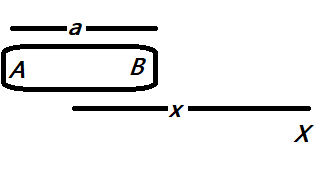Question
Question: Derive an expression for the electric potential at a point along the axial line of an electric dipol...
Derive an expression for the electric potential at a point along the axial line of an electric dipole. At a point charge, the values of the electric field and potential are 25N/Cand 10J/C. Then calculate:
A. the magnitude of the charge
B. distance of the charge from the point of observation
Solution
We know that the electric potential due to a charge, is defined as the amount of energy needed to move a unit positive charge to infinity. Also the potential at any point is the vector sum of potentials at that point. Also, potential is proportional to the charge and inversely proportional to the square of the distance between the point and the charge.
Formula used:
x=EXVX and V=rKq
Complete step by step answer:
Consider an electric dipole AB of length a and let X be a point on the axial line such that it is at a distance x from the centre of the dipole AB.

Then the electric potential at the point X is given as,VX=V+q+V−q
Or, VX=K[x−aq+x+a−q]=x2−a2K(2qa)=x2−a2KP, where P is the dipole moment of the electric dipole ABof length a and K is the coulombs constant which is equal to 9×109Nm2/C
Given that , the electric potential VX=10J/C and the electric field EX=25N/C
Then we know that, E=rV where r is the distance of the charge, substituting the values, we get, x=EXVX
Then, we get x=2510=0.4m
i.e the distance of the X from the from the centre is 0.4m
Also from the definition of electric potential, we know that , V=rKq , then substituting the values we get,
q=KVXx=9×10910×0.4=4.45×10−10C
i.e. the magnitude of each charge is 4.45×10−10C
Hence the answers are as follows:
A. the magnitude of each charge is 4.45×10−10C and
B. the distance of the X from the from the centre is 0.4m
Note:
To find the charge you can also use the EX as EX=x2Kq. Also, the value of charge q calculated here, is only one charge of the dipole. Note the dipole moment P=2aq. This is taken for simplification and easy calculations. Also, K=4πϵ01.
